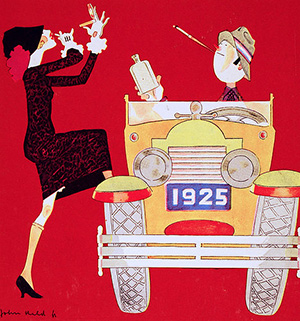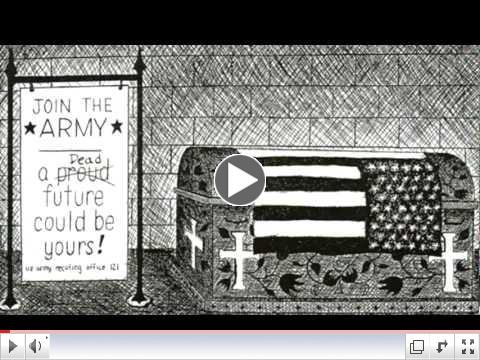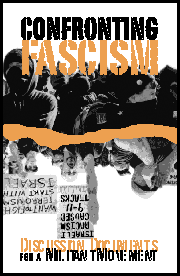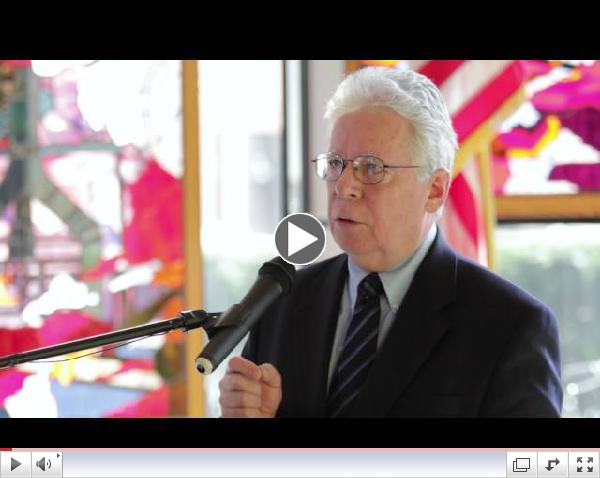CCDS Statement on Hugo Chavez 
The Committees of Correspondence for Democracy and Socialism shares in the grief of the people of Venezuela, Latin America and freedom loving people throughout the world in the loss of Venezuela's President Hugo Chavez...
|
|
International Women's Day, March 8...
This is one of the women combatants of the Paris Commune, dreaded and derided by the victorious bourgeoisie. Her name is Hortense David. When the commune fell, she was charged with being a "pointeur [des pičces] - in other words aiming artillery at the forces of counter-revolution - and sentenced to life in prison. --Dennis O'Neil
|
Dialogue & Initiative 2012 The new annual edition of our journal of discussion and analysis is now out. More than 130 pages, it includes 13 articles related to the Occupy! movement, as well as seven others vital to study in this election year. Cost is $10 plus shipping. Or get one by becoming a sustainer. Click the title to buy it directly.
|
New Issue of Mobilizer

Check out what CCDS has been doing...
|
Blog of the Week:

'A concentration camp for little boys': Dark secrets unearthed in KKK county. Excavators discover 50 bodies buried in the grounds of a boys' borstal, which was only shut in 2010...
|
Lost Writings of SDS..
Revolutionary Youth the the New Working Class: The Praxis Papers, the Port Authority Statement, the RYM Documents and other Lost Writings of SDS
Edited by Carl Davidson 
Changemaker, 273pp, $22.50
For the full contents, click the link and view 'Preview' under the cover graphic.
|
|
By Randy Shannon, CCDS

"Everyone has the right to work, to free of employment, to just and favorable conditions of work and to protection against unemployment."
- United Nations Universal Declaration of Human Rights, December 10, 1948
I. Introduction
The "Great Recession" that began in 2007 has caused the greatest percent of job losses since the Great Depression of 1929. This crisis is the end of an era of unrestrained 'neo-liberal' capitalism that became public policy during the Reagan administration. The crisis marks a new level of instability with the growth of a global financial elite that targeted US workers and our trade unions after World War II.
|
|
Order Our
Full Employment Booklets
 |
...In a new and updated 2nd Edition
Capitalism may well collapse under its own excesses, but what would one propose to replace it? Margaret Thatcher's mantra was TINA...There Is No Alternative. David Schweickart's vision of "Economic Democracy" proposes a serious alternative. Even more fundamentally, it opens the door to thinking about alternatives. His may or may not turn out to be the definitive "successor system," but he is a leader in breaking out of the box. |
|
Quick Links...
CCDS Discussion |
Sex and the Automobile in the Jazz Age

By Peter Ling in History Today: 'Brothels on wheels' thundered the moralists but Peter Ling argues the advent of mass motoring in the 1920s was only one of the changes in social and group relationships that made easier the pursuit of carnal desire.
|
 A Memoir of the 1960s by Paul KrehbielAutumn Leaf Press, $25.64 A Memoir of the 1960s by Paul KrehbielAutumn Leaf Press, $25.64 | | Shades of Justice Video: Bringing Down a President, Ending a War |
|
Carl Davidson's Latest Book:
New Paths to Socialism

Essays on Mondragon, Marx, Gramsci and the Green and Solidarity Economies |
Solidarity Economy:What It's All About

Edited by Jenna Allard, Carl Davidson and Julie Matthaei
Buy it here...
|

Voices from the Underground Press of the 1960s, Part 2- Foreword by Susan Brownmiller
- Preface by Ken Wachsberger
$37.50 + $6 shipping
|
|
Discussion Documents for a Militant Movement

By Don Hamerquist
|
|
|
|
An Invitation to CCDSers and Friends...
 Rewarding the Banksters with the Poor's Pittances: Trap Waiting for Obama
We're the Committees of Correspondence for Democracy and Socialism...Do you have friends who should see this? Pass it on...Do you have a blog of your own? Others you love to read every day? Well, this is a place where you can share access to them with the rest of your comrades. Just pick your greatest hits for the week and send them to us at carld717@gmail.com!
Most of all, it's urgent that you defend voter rights, plan for 2014 races now, oppose austerity, make solidarity with the Occupy! movement and end the wars! We're doing more than ever, and have big plans. So pay your dues, make a donation and become a sustainer. Do it Now! Check the link at the bottom...
|
By Robert Kuttner
American Prospect via Portside
Feb 26, 2013 - President Barack Obama urges Congress to come up with a plan to avert the automatic spending cuts set to kick in on March 1, 2013 last week.
President Obama has miscalculated both the tactical politics of the sequester and the depressive economic impact of budget cuts on the rest of his presidency. The sequester will cut economic growth in half this year. But it's now clear, one way or another, that we will get cuts in the $85 billion range that the sequester mandates this fiscal year. All that remains are the details.
Obama's miscalculation began in his fist term, with his embrace of the premise that substantial deficit cutting was both politically expected and economically necessary, and his appointment of the 2010 Bowles-Simpson Commission as the expression of that mistaken philosophy. Although the Commission's plan was never carried out, its prestige and Obama's parentage of it locked the president into a deflationary deficit reduction path.
This past week, we've seen how the Republicans took advantage of Obama's self-inflicted wound. With the March 1 deadline looming, the White House assumed that if the president gave enough publicity to the harm of pending automatic cuts, the Republicans would just cave. But the Republican leadership calculated that the ensuing political and economic damage would be worse for Obama, so they hung tough.
Obama also assumed that military cuts would be enough to move Republicans to compromise. But with two wars winding down, most Republicans decided that this year they were deficit hawks more than defense hawks.
The president also played the populist card, calling for tax increase on the wealthy to spare the rest of the country program cuts. But that didn't move the Republicans either.
The Republican leadership also deftly evaded the risk of being blamed for shutting down the government. They offered the Democrats a continuing resolution to allow government to keep operating, but at $85 billion below current spending levels. That shifted the onus to Democrats if they refused to take the deal and Congressional leaders advised the president that they were not prepared to take that risk.
Finally, Republicans took some of the sting-and responsibility-out of the sequester by offering to give Obama new flexibility in how he implemented it, thus making it even more his problem.
Next to come is the long awaited grand bargain of the austerity lobby, in which Republicans agree to close some tax loopholes (which start out grotesquely swollen) and Democrats agree to breach the previously sacrosanct fortresses of Social Security and Medicare.
On all counts, advantage: Republicans....(Click title for more)
|
|

By Marta Harnecker
SolidarityEconomy.net
When Hugo Chávez triumphed in the 1998 presidential elections, the neoliberal capitalist model was already floundering. The choice then was none other than whether to re-establish the neoliberal capitalist model -- clearly with some changes including greater concern for social issues, but still motivated by the same logic of profit seeking -- or to go ahead and try to build another model.
I believe that Chávez's chief legacy is having chosen the latter alternative. To name that alternative, he also chose to reclaim the word socialism, despite the negative baggage that the word had acquired, at the same time, however, clarifying that his was 21st-century socialism in order to distinguish it from Soviet socialism implemented during the 20th century, warning that we must not "fall into the errors of the past," into the "Stalinist deviation" that bureaucratized the party and ended up eliminating common people's protagonism, into state capitalism that put emphasis on state property rather than workers' own management of enterprises.
Chávez conceived of socialism as a new collective life in which equality, freedom, and real and deep democracy reign, and in which the people plays the role of protagonist; an economic system centered on human beings, not on profits; a pluralistic, anti-consumerist culture in which the act of living takes precedence over the act of owning.
Chávez thought, like Mariátegui, that 21st-century socialism cannot be a "carbon copy" and must be a "heroic creation," which is why he spoke of Bolivarian, Christian, Robinsonian,1 Amerindian socialism.
The necessity of common people's protagonism is a recurring theme in the late Venezuelan president's speeches and an element that distinguishes his from other proposals for democratic socialism. Participation, as protagonists, in all spheres is what allows human beings to grow and achieve self-confidence, that is to say, to develop themselves as human beings.
But this would have remained mere words if Chávez had not promoted the creation of spaces suitable for participatory processes to fully come into their own. That is why his initiative to create communal councils (self-managed community spaces), workers' councils, student councils, and peasant councils is so important, for the purpose of forming a truly collective structure, which must express itself as a new form of decentralized state whose fundamental building blocks should be communes.
Building with people, for Chávez, meant winning their hearts and minds for a new social project. And this cannot be done by sermons, it can only be done through practice: creating opportunities for people themselves to become the builders of the project and thus to understand the project as theirs. Hence his advice: "Beware of sectarianism. Indeed there are people . . . who don't participate in politics, who don't belong to any party. Well, that's OK. They are welcome. Not only that, if there's someone from the opposition around here, give him a shout-out. Let him work and be useful. This country belongs to everyone. Open up spaces, and you'll see that through practice many people will change themselves."2 ...(Click title for more)
|

Historian Mark Solomon looks at the prospects for a new socialist left
By Mark Solomon
Published by Portside, March 6, 2013
On February 4, 2010 The Gallop Poll released its latest data on the public's political attitudes. The headline read: "Socialism Viewed Positively by 36% of Americans." While the poll did not attempt the daunting task of exploring what a diverse public understood socialism to mean, it nevertheless revealed an unmistakably sympathetic image of a system that had been pilloried for generations by all of capitalism's dominant instruments of learning and information as well as by its power to suppress and slander socialist ideas and organization.
In sheer numbers, that means a population at the teen- age level and above of tens of millions with a favorable view of socialism.
Why then is the organized socialist movement in the United States so small and so clearly wanting in light of the potential for building its numbers and influence?
That is a crucial question. At every major juncture in the history of the country, radical individuals and organizations in advance of the mainstream have played essential roles in influencing, guiding and consolidating broad currents for social change. In the revolution that birthed this country, radical activists articulated demands from the grass roots for an uncompromising and transforming revolution to crush colonial oppression. Black and white abolitionists fought to make the erasure of slavery the core objective of the Civil War while also linking that struggle to women's suffrage and trade unionism. A mass Socialist Party in the early 20th century fought for state intervention to combat the ravages of an increasingly exploitative economic system while advancing the vision of a socialist commonwealth. In the Great Depression, the Communist Party and its allies fought the devastations of the crisis - helping to build popular movements to expand democracy, grow industrial unions and defend protections for labor embodied in the historic New Deal.
Small left and socialist organizations in the sixties supported a range of progressive struggles from peace to civil rights to women's liberation to gay rights and beyond. The limited resources of those groups were effective in galvanizing massive peace demonstrations and in campaigns against racist and sexist oppression. But the Cold War and McCarthyism had eviscerated any hope for a major influential socialist current. Consequently, no large and impacting force existed to extend to the peace movement a coherent anti-imperial analysis that might have contributed to its continuity and readiness to confront the wars of the nineties and the new century. Nor was there a strong socialist organization to contribute to the civil rights struggle by advocating for reform joined to a commitment to deeper social transformation. Had such a current existed, it might have contributed to building a broad protective barrier against the devastating FBI and local police violence against sectors of the movement like the Black Panthers.
There should be little debate today on the left over the need for a strong socialist voice and movement in light of festering economic stagnation, war on the working class, looming environmental catastrophe, a widening chasm between the super-rich and the rest of us, massive joblessness and incarceration savaging African Americans and other oppressed nationalities, crises in health care, housing and education. Such a strong socialist presence could offer a searching analysis of the present situation, help stimulate a broad public debate on short term solutions and formulate a vision of a socialist future that could begin to reach the minds and hearts of the 36 percent who claim to be sympathetic to that vision. ...(Click title for more)
|
 The Steelworkers deal that could turn the rust belt green. The Steelworkers deal that could turn the rust belt green.
By Amy Dean
Yes! Magazine
March 05, 2013 - "Too often we have seen Wall Street hollow out companies by draining their cash and assets and hollow out communities by shedding jobs and shuttering plants," said United Steelworkers (USW) President Leo Gerard in 2009. "We need a new business model that invests in workers and invests in communities."
Gerard was announcing a formal partnership between his 1.2-million-member union and Mondragon, a cluster of cooperatives in the Basque region of Spain.
 | | Worker Ownership for the 99% Press Conference |
Mondragon employs 83,000 workers in 256 companies. About half of those companies are cooperatives, and about a third of Mondragon's employees are co-op members with an ownership stake in their workplace. Mondragon companies do everything from manufacturing industrial machine parts to making pressure cookers and home appliances to running a bank and a chain of supermarkets. With billions of euros in annual sales, Mondragon is the largest industrial conglomerate in the Basque region and the fifth-largest in Spain.
The cooperatives use workers' cash investments as part of the capital needed to finance new projects, and worker-owner co-op members get to vote on strategy, management, and business planning. The highest-paid managers' salaries are capped at six to eight times what the lowest-paid workers make-as opposed to the United States, where CEOs now make 380 times more than the average worker.
Building union co-ops
As manufacturing in the United States continues in free fall, the USW is working to bring the Mondragon cooperative model to the Rust Belt. It aims to use employee-run businesses to create new, middle-class jobs to replace union work that has gone overseas.
A March 2012 report from the USW, Mondragon, and the Ohio Employee Ownership Center (OEOC), lays out a template for how "union co-ops" can function. "A union co-op is a unionized worker-owned cooperative in which worker-owners all own an equal share of the business and have an equal vote in overseeing the business," the report states.
"While it may not rebuild labor's ranks ... this model might do something even more important: give working people a way to become true stewards of the economy."
But how do union co-ops differ from traditional worker-owned co-ops? The report explains that the key difference is that workers in a union co-op can appoint a management team (from within their own ranks or from outside the co-op) and then bargain collectively with management. The resulting collective bargaining agreements can set wage rates for all the co-op's jobs, choose health care and other benefit packages, decide how workers will earn time off, and determine a process for grievances and arbitration of workplace disputes.
In addition to producing the union co-op template, the USW has worked to get pilot cooperatives started in the United States. The union has carefully examined the Evergreen Cooperatives, which were started in Cleveland in 2009 with a blend of foundation money, public funds, and private investment capital. Drawing from Mondragon's principles of shared prosperity for workers and democratic governance, Evergreen launched a commercial laundry that now cleans more than four million pounds of laundry per year and employs 30 people. It also has plans for a solar installers' cooperative and a greenhouse that grows high-end salad greens and herbs for the Cleveland Clinic, as well as universities and restaurants. The example was an important one for the USW's pilot projects, suggesting a blueprint to keep jobs local, tie new businesses to existing city institutions, and give workers a voice in company operations.
OEOC Director Bill McIntyre worked with the Cleveland Foundation on crafting the organizational framework for the Evergreen Cooperatives. At a March 2012 press event at United Steelworkers headquarters, he observed that employee-owners more often kept their jobs during the recent economic meltdown. "Employee-owned companies," he said, "have more stable, loyal, and experienced work forces, which translates into real cost savings, productivity, and quality advantages."...(Click title for more)
|
 By Laura Clawson By Laura Clawson
DailyKOS
President Barack Obama signed the recently passed version of the Violence Against Women Act Thursday, a week after Speaker John Boehner finally allowed the House to vote on the bipartisan bill.
Obama and Vice President Joe Biden spoke to a crowd of legislators, activists, law enforcement, and advocates, highlighting the accomplishments of the Violence Against Women Act over 19 years and its continuing relevance.
Speaking before the president, Biden, one of the law's original sponsors in 1994, both recalled the fight to get the original law passed, recognizing many of the participants in that fight and in the one to get the reauthorization passed this year, and tied violence against women to an issue much discussed today, saying, "From 2009 to 2012, 40 percent of the mass shootings in America, other than the celebrated ones you've seen-40 percent where there's four or more people who have been shot, the target has been a former intimate partner or a close family member." Obama, too, cited gun violence, mentioning both legislation in Congress now and the recent shooting death of Hadiya Pendleton weeks after she marched in the inauguration parade.
"One of the great legacies of this law is that it didn't just change the rules," Obama continued:
[I]t changed our culture. It empowered people to start speaking out. It made it okay for us, as a society, to talk about domestic abuse. It made it possible for us, as a country, to address the problem in a real and meaningful way. And it made clear to victims that they were not alone-that they always had a place to go and they always had people on their side.
That this reauthorization took so long is entirely at the feet of House Republican leadership for refusing to allow a vote on the Senate's bipartisan bill in 2012 and then doing a little more foot-dragging in 2013. But it is done. That just means, though, that it's time to press on to the next step forward. Having increased protections and services for victims of domestic violence and sexual assault is necessary, but we can do more. Women need the Paycheck Fairness Act so we can more effectively fight pay discrimination. For that matter, we need the Equal Rights Amendment, so we can more effectively fight every kind of discrimination.
Let's keep moving forward. Tell Congress to pass the Equal Rights Amendment.
|
 Otis Redding:
Lonely & BlueStax Records
By Bonnie Stiernberg
Paste Magazine
March 5, 2013 - These are not songs for daylight.
Don't misunderstand me: the answer to "Should I be listening to Otis Redding right now?" is always yes. But the tracks on Lonely & Blue are not the Redding songs you're going to turn to while the sun is still out.
No, these are the tunes for the end of the night, the ones that pop and hiss on your turntable as you pour yourself one last drink, sit on the foot of your bed, kick off your shoes and wince a little as you rub where they had been digging into your heels. They're the ones that come pleading through the speakers before last call at a smoky bar, when the evening's revelry is winding down and you can no longer tell if the couples on the dancefloor are swaying in sweet embraces or simply propping each other up.
Described in press materials as "the best album Otis never made," Lonely & Blue is a compilation of the soul legend's best ballads, lovingly put together and sequenced by producer David Gorman-who also designed the record's artwork, complete with 1960s-style typeface to make it look like something you'd find collecting dust in your parents' basement, and penned its liner notes in the present tense as a fictional DJ. It's clear Gorman loves Redding as much as the rest of us, and instead of feeling like it's coming from a studio executive in a bad suit with dollar signs in his eyes, Lonely & Blue feels like a mix CD from a friend, that Otis obsessive you know who really wants to make sure you get the deep cuts-so much so that he's hand-labeled it and annotated each track for you.
The record begins with an entreaty: "Please, let me sit down beside you," he implores on "I Love You More Than Words Can Say." "I've got something to tell you you should know." Anyone who's seen a romantic comedy can predict the big declaration that's coming-only nothing's funny here. Otis is serious as a heart attack, saying his piece as only he can, with the kind of emotional vocal straining that makes you stop and catch your breath even though you're just a spectator....(Click title for more)
|
Gar Alperovitz is out with his new book, "What Then Must We Do? Straight Talk About The Next American Revolution." Alperovitz and discusses Health Care, Wages, and other American concerns with Laura Flanders. What do you think, could there be a revolution on the way? Following is also a comment on the Common Dreams site from 'Drone!' Click the picture to watch the interview. 
Drone1: Prevailing theory of revolution holds that two things must be present for revolution to occur. The first is that the state breaks down, which we are definitely doing. This is the easy part (theoretically). The American political system is, as pointed out in the video, simply not functional to govern a country properly.
The second, though, is the trickier part. There must exist a split among elites ideologically. This often occurs when elites attempt to address a broken state. If there is unanimity, repression becomes both more likely and more intense--meaning effective--as there is little disagreement among the powerful as to how the state should go about preserving itself.
But if elites are significantly divided about how the state should reassert it's legitimacy and functionality--for example, should we become more democratic? should we become less democratic? should we distribute more capital downward? or should we extract the very last for our class and allow a full and open transition to a class-based tyranny?--then the state becomes hamstrung about how to respond to external pressure.
This creates a momentary "window"; a brief vacuum of opportunity where revolutionary force can be successful in toppling the state as it is not capable of fully defending itself. If the split is deep and radical between elites, the window can be extended for a very long time (see Russia, France and the US for examples of that).
It's the second part that's a problem for us. Elites are as unanimous in many matters as I've ever heard them being. But perhaps that's just on the surface. There do appear to be cracks showing up on the question of inequality, and that might be the break needed for another American revolution to occur. But these windows are not open for all that long, and they require a highly organized push in order to be able to take advantage of opportunities should they arise. This was always the Marxist formula, and it worked well enough in the 20th century in many places. But with the demise of radical organization, there is nothing remotely in existence that could provide a revolutionary vehicle to acquire the power of the existing state.
My feeling as someone who studied revolution and insurgency in grad school is that we're more likely to break down into a more classic civil war before a revolution, although the overlap between the two phenomenon is pretty considerable.
But the difference between the two is key: a revolution WILL change the dominant ruling paradigm in a polity. A civil war has no such requirement. It merely changes the cabal in power, but it doesn't have to change the nature of the country or the ideological dominance of the prevailing worldview of the toppled state.
It's good that someone "respectable" like Alperovitz is talking about it in general terms. But we're a long way from being able to remake the American state into something many of us would prefer to see.
|
|
Become a CCDS member today!
 The
time is long past for 'Lone Rangers'. Being a socialist by your self is
no fun and doesn't help much. Join CCDS today--$36 regular, $48
household and $18 youth. The
time is long past for 'Lone Rangers'. Being a socialist by your self is
no fun and doesn't help much. Join CCDS today--$36 regular, $48
household and $18 youth.
Better yet, beome a sustainer at $20 per month,
and we'll send you a copy of Jack O'Dell's new book, 'Climbing Jacobs
Ladder,' drawing on the lessons of the movement in the South in the
1950s and 1960s.
Solidarity, Carl Davidson, CCDS |
|
|